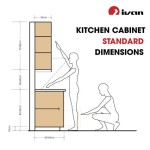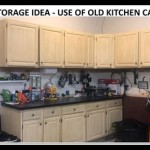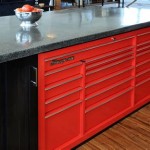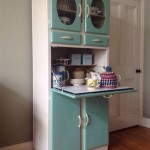Under Sink Cabinet Mat: Protection and Organization for Your Kitchen
The under-sink cabinet often becomes a neglected space, prone to dampness, spills, and clutter. Cleaning supplies, plumbing fixtures, and the potential for leaks create an environment that can lead to damage and disorganization. An under-sink cabinet mat, drip tray, or shelf liner provides a practical solution to these problems, offering protection against water damage, facilitating easier cleaning, and contributing to overall cabinet organization.
These protective mats come in various materials, sizes, and designs, each with its own set of advantages and disadvantages. Understanding the options available and their intended purpose is crucial for selecting the right product to suit individual needs and ensure long-term functionality. Factors such as material durability, water resistance, ease of cleaning, and compatibility with existing cabinet dimensions play a significant role in the decision-making process.
The primary function of an under-sink cabinet mat is to protect the cabinet base from water damage. Leaks from plumbing connections, spills from cleaning products, or condensation can all cause significant damage to the wood or laminate construction of the cabinet. Over time, prolonged exposure to moisture can lead to warping, mold growth, and even structural weakening. A quality under-sink mat acts as a barrier, preventing liquids from seeping into the cabinet material and minimizing the risk of such damage.
Beyond protection, these mats also contribute to a more organized and easily maintained under-sink space. By providing a smooth, flat surface, they create a more stable base for storing cleaning supplies and other items. This, in turn, reduces the likelihood of spills and makes it easier to access and retrieve items when needed. The organized space also simplifies the cleaning process, allowing for quick and efficient removal of debris and spills.
Installation of an under-sink cabinet mat is typically a straightforward process, often requiring minimal tools or effort. Many mats are designed to be easily trimmed to fit specific cabinet dimensions, ensuring a snug and secure fit. The installation process usually involves measuring the cabinet interior, cutting the mat to size, and then placing it inside the cabinet. Some mats may also feature adhesive backing or non-slip surfaces to further enhance their stability and prevent shifting.
Key Point 1: Material Composition and its Impact on Performance
The material from which an under-sink cabinet mat is made directly influences its performance in terms of water resistance, durability, and ease of cleaning. Several common materials are used in the construction of these mats, each with its own unique properties:
Plastic: Plastic mats, often made from polyethylene or polypropylene, are a budget-friendly option that provides good water resistance. They are generally easy to clean and can withstand exposure to most household chemicals. However, plastic mats may be less durable than other materials and can be prone to cracking or tearing under heavy use or extreme temperatures. They also may not offer the same level of grip or non-slip properties as those made with other materials.
Silicone: Silicone mats are known for their excellent water resistance, heat resistance, and durability. They are also highly resistant to chemicals and are easy to clean. Silicone mats often feature a non-slip surface, providing added stability for stored items. While silicone mats are generally more expensive than plastic mats, their superior performance and longevity make them a worthwhile investment for many homeowners.
Rubber: Rubber mats offer a good balance of water resistance, durability, and affordability. They are more resistant to tearing and cracking than plastic mats and provide a decent level of grip. However, rubber mats may have a distinct odor that can be noticeable, especially when new. They also may be more difficult to clean than plastic or silicone mats, as they can be porous and absorb spills.
Metal: Metal drip trays, typically made from stainless steel or aluminum, offer the highest level of durability and water resistance. They are also resistant to rust and corrosion and can withstand exposure to high temperatures. Metal drip trays are often used in commercial settings or in areas where heavy-duty protection is required. However, they can be more expensive than other types of mats and may not be as aesthetically pleasing for some homeowners. They can also be noisy when items are placed upon them.
The selection of the appropriate material should be based on the specific needs and budget of the individual. Consider the potential for spills, the type of cleaning products used, and the desired level of durability when making a decision.
Key Point 2: Design Features and Functionality
Beyond the material, the design of an under-sink cabinet mat can also significantly impact its functionality and ease of use. Several design features are commonly incorporated into these mats to enhance their performance:
Raised Edges: Raised edges around the perimeter of the mat create a containment area that prevents spills from spreading beyond the mat's surface. This feature is particularly useful in preventing water or cleaning product spills from seeping into the cabinet walls or onto the floor. The height of the raised edges can vary, with higher edges providing greater containment capacity.
Non-Slip Surface: A non-slip surface ensures that items stored on the mat remain stable and prevents them from sliding around when the cabinet door is opened or closed. This feature is especially important for storing bottles of cleaning solutions or other items that could easily tip over. Non-slip surfaces can be achieved through the use of textured materials, rubberized coatings, or strategically placed grips.
Pre-Cut Holes or Perforations: Some mats feature pre-cut holes or perforations to accommodate plumbing pipes or other obstructions. This eliminates the need for custom cutting and ensures a clean, professional-looking installation. Alternatively, mats can be designed with flexible materials that can be easily cut and shaped to fit around pipes.
Drainage Grooves or Channels: Drainage grooves or channels on the surface of the mat allow water to flow away from stored items, reducing the risk of mold or mildew growth. This feature is particularly useful in areas with high humidity or where leaks are common. The channels direct the water toward the edges of the mat, where it can be easily wiped up.
Removable Inserts or Trays: Some mats incorporate removable inserts or trays that can be easily lifted out for cleaning. This feature simplifies the cleaning process and allows for thorough removal of spills or debris. These inserts are often made from durable, water-resistant materials that can be easily wiped down or washed.
Careful consideration of these design features can help in selecting a mat that provides the best combination of protection, organization, and ease of use for the specific under-sink environment.
Key Point 3: Proper Installation and Maintenance
Even the highest quality under-sink cabinet mat will not perform effectively if it is not installed and maintained properly. Following these guidelines will help ensure long-term protection and functionality:
Accurate Measurement and Cutting: Before installing the mat, carefully measure the interior dimensions of the cabinet. Trim the mat to fit the cabinet precisely, ensuring that it covers the entire base and extends up the sides as much as possible. Use a sharp utility knife or scissors to make clean, accurate cuts. Avoid leaving gaps or overlaps that could allow water to seep through.
Secure Placement: Ensure that the mat is securely placed inside the cabinet. If the mat has adhesive backing, carefully peel off the protective liner and press the mat firmly into place. If the mat does not have adhesive backing, consider using double-sided tape or non-slip grips to prevent it from shifting. Make sure the mat lies flat against the cabinet base, without any wrinkles or creases.
Regular Cleaning: Clean the mat regularly to remove spills, debris, and accumulated moisture. Use a mild detergent and warm water to wipe down the mat's surface. For stubborn stains or spills, use a specialized cleaner designed for the mat's material. Avoid using harsh chemicals or abrasive cleaners, as they can damage the mat's surface.
Prompt Spill Response: Immediately wipe up any spills that occur on the mat. The longer spills are left unattended, the greater the risk of water damage to the cabinet. Use a clean cloth or paper towel to absorb the spill thoroughly. Pay particular attention to areas around plumbing connections or containers of cleaning products.
Periodic Inspection: Regularly inspect the mat for signs of wear and tear, such as cracks, tears, or discoloration. Replace the mat if it becomes damaged or compromised in any way. Also, inspect the area underneath the mat for any signs of moisture or mold growth. Address any leaks or plumbing issues promptly to prevent further damage.
By following these installation and maintenance guidelines, homeowners can maximize the lifespan and effectiveness of their under-sink cabinet mat, providing long-term protection against water damage and contributing to a more organized and hygienic under-sink environment.
The benefits of using an under-sink cabinet mat extend beyond simple protection against water damage. It enhances the overall functionality and organization of the under-sink space, making it easier to store and access cleaning supplies. It also contributes to a cleaner and more hygienic environment, reducing the risk of mold and mildew growth.
Choosing the right under-sink cabinet mat requires careful consideration of various factors, including material, design, size, and budget. By understanding the different options available and their respective advantages and disadvantages, homeowners can make an informed decision that meets their specific needs and provides long-term value.
Ultimately, investing in a quality under-sink cabinet mat is a simple yet effective way to protect cabinets from water damage, improve organization, and create a more pleasant and functional kitchen environment. It is a worthwhile investment that can save time, money, and frustration in the long run.

Xtreme Mats 37 In X 22 Beige Kitchen Depth Under Sink Cabinet Mat Drip Tray Shelf Liner Cm 39 The Home Depot

Reviews For Xtreme Mats 34 In X 22 Grey Kitchen Depth Under Sink Cabinet Mat Drip Tray Shelf Liner Pg 1 The Home Depot

Xtreme Mats Kitchen 22 In X 34 Grey Undersink Drip Tray Fits Cabinet Size Km15 At Com

Mat Under Sink Drip Tray Shelf Liner With Drain Hole Durable Cabinet

Xtreme Mats Kitchen 22 In X 34 Beige Undersink Drip Tray Fits Cabinet Size Km02 At Com
Sunjoy Tech Under Sink Mat Anti Slip Silicone Waterproof Multipurpose Shelf Liner Drip Tray Kitchen Bathroom Cabinet Protector Pad Supplies Business

Have A Question About Xtreme Mats 25 In X 22 Grey Kitchen Depth Under Sink Cabinet Mat Drip Tray Shelf Liner Pg 2 The Home Depot

Under Sink Mat Water Resistant Silicone Drip Tray Shelf Liner For Kitchen Bathroom 34 In X 22

Mat Under Sink Kitchen Cabinet Shelf Drawer Liners Tray Drip 30 150cm

Xtreme Mats Waterproof Under Sink Mat For Kitchen Laundry Cabinets Beige 34 1 4 X 22 Cabinet Shelf Protector Flexible Drip Tray Liner
Related Posts








